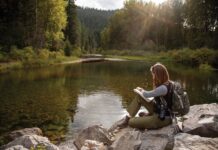
Whether you’re planning a trip abroad, a weekend getaway, or a staycation this summer, it’s a great time to take advantage of the good weather and long days for painting outside. If you plein air paint regularly, you know how rewarding it can be to work directly from nature and capture an awe-inspiring sunset, light-dappled barn, or children playing in the surf. If you’ve never tried it, however, Erik Speyer, has got some tips for making the most of the experience. As you’ll discover, it doesn’t take long to capture a special moment in time and create a personal, lifelong reminder of where you’ve been and what you experienced.

Painting Fast on Location
By Erik Speyer
I live in New Mexico, where the landscape can be very wide. I’ve found that making sketches in a 5 x 8 -inch Moleskine watercolor sketchbook (in 30 minutes or less) is a great way to capture interesting scenes on location. The advantages to working this way are that it’s fast and, because you’re working in a sketchbook, the paintings are just for yourself, so you can afford to be more experimental and loose than you would be in your studio work or on work you intend to sell.

Artist’s Sketching Toolkit
In addition to the sketchbook, I carry:
- one, inexpensive #10 round brush with a good point
- a 5 x 8-inch plastic folding palette that I fill with 12 Windsor & Newton paints.
- a thermos filled with water both for drinking and for painting
- two or three sheets of paper towel, which will usually last me the whole day
- my lunch
- a bag to carry it all in
Plus, I do have a very small three-legged folding stool in the car, but usually I sit on rocks, park benches, fallen trees, or even the hood of my car. I’ve found that the more uncomfortable the seat, the faster I paint.
Watercolor Sketching Process
To start, I quickly place the major features of the scene with pencil to make sure it fits into this wide format. The extreme horizontal dimensions of the 5 x 16-inch open sketchbook forces me to look at a scene differently than I normally would. I actually have to move my head from side to side, not just look straight ahead, because so much more of the landscape fits on the paper. The paper’s limited height, but generous width, literally stretches the painting, forcing the inclusion of details that otherwise would not have been part of a painting with typical dimensions.

One of the dangers of painting in this format is that the horizon may not move seamlessly from one page to the other — a problem especially hard to catch since there is little opportunity to step back and look at your work.
Using one relatively large brush adds to the speed at which you can work. For large areas it can be laid down on its side, and for detailed finishes, the point will do all the work.

Since these sketches are primarily for fun or study, no one else may ever see them. They’re a perfect excuse to experiment with colors, textures, and washes. If the painting “goes south,” then simply move on to the next page.
I have sometimes done several paintings in the same location, turning 90 degrees or more each time to capture what was on my right or left, or behind me. The paintings only take about 25 minutes to complete unless it’s an interior or a street scene, which can take a bit longer.

When I’m painting outside, I’ve learned to look at a scene and determine at the start what details are unimportant and to be left out, making those elements that are painted much more dramatic and interesting.
Sketching your favorite landscapes or those you encounter on your travels is a rewarding way to capture a scene or a memory that certainly beat photographs for relieving the moment.
For more inspiring stories like this one, sign up for our free weekly e-newsletter.







